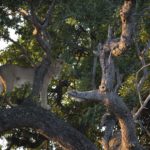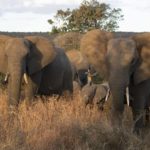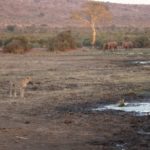Our past three days were spent in Kruger National Park. We sat around a bonfire, watched the stars, and spent hours on safari. Although Shishangeni Lodge was the site of great fun and food, the safaris were what repeatedly blew my mind.
The nine of us hopped into the jeeps twice at 6:30 am and twice at sundown. We saw sunsets and virtually the entire cast of The Lion King. In one moment, we sat feet from a lion in a tree, an anomaly our guide has seen twice in her decade working as a ranger. In another, a cheetah slinked towards our car, holding eye contact the entire time. We laughed for hours over the way giraffes run (please YouTube this!) and my unfortunate identification of hippos as rocks.
After expressing our love of elephants to our guide, Sifiso, we found ourselves feet from a herd of fifteen elephants. We were star struck. Sifiso told us afterwards that he could not have turned the car on until they decided to leave. They would have “fled or charged” at the sound of the engine.
Each individual memory is spectacular, with sunsets, hot chocolate, and photoshoots in between. I will never forget this trip, and I hope to go back one day. However, as we were driving around the park, I couldn’t help but wonder how climate change might damage this beautiful place.
Kruger is already feeling the effects of global warming, with damage only predicted to increase in coming years. The park is located in northeastern South Africa. In the country’s recent “National Climate Change Report,” it has become apparent that change in water activity is the main cause for concern. From storms to droughts, our actions are already impacting people and animals in the country. Kruger is no different. Experts report the loss of “some of the world’s most sensitive and valuable river habitats,” forests, and species diversity in Kruger as a result of flooding, which will only increase over time (“Floods Caused by…).
Water damage is only one example of a much larger problem. I am not an expert, but I find one statistic to be particularly shocking and disturbing in reference to the overall impact of climate change in Kruger. A 2001 study states that a 2 degree Celsius increase in temperature could destroy two-thirds of species in the park (“Vulnerability of South…). Current data on global temperature change indicate that this increase is predicted to occur within the next hundred years (The Effects of…).
These data are, sadly, rather unsurprising. We hear stories like this all the time. Except it isn’t really a story, it’s science. Fact. Climate change will affect all of us in so many ways. But I find myself thinking more about this after experiencing something as truly magical as Kruger National Park.
Although we happened to discuss our amazement at the detail of Disney’s depictions of these animals, I hope that Disney will not become the only place we see these creatures. I hope we in our communities, nations, and world can address global warming before our actions continue to do catastrophic damage. I hope that more people can experience herds of elephants, running giraffes, and lions watching a sunset, as we had the great fortune of witnessing in these past few days.
Photos courtesy of Kellen Silver.




